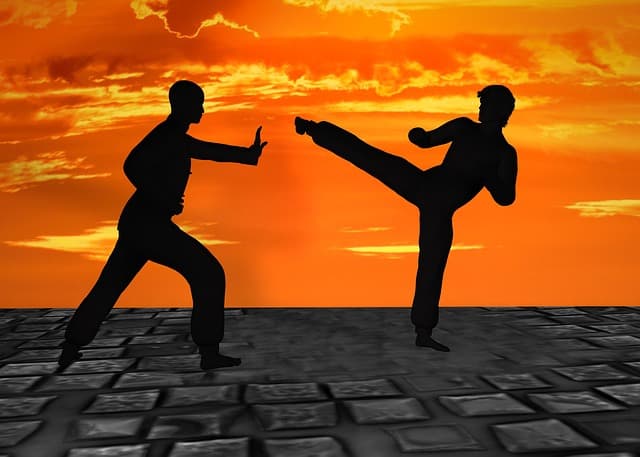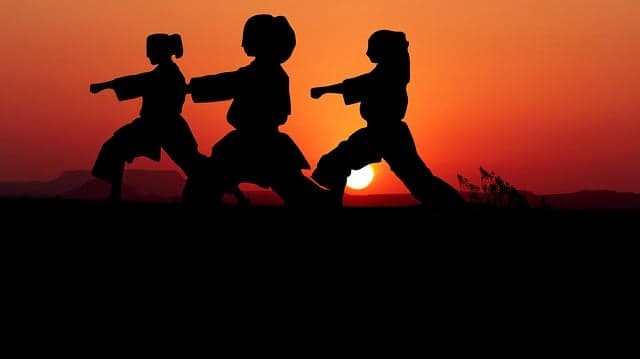In the school of martial arts you can engage in such sports as hand-to-hand fighting, traditional and combat jiu-jitsu, Choi Kwan Do. There are also programs for men and women’s self-defense, yoga and breathing exercises.

Men’s and Women’s Self-Defense
Self-defense is a broad concept, which refers primarily to the personal safety of a person. In this regard, the concept of self-defense has a fairly wide range of different aspects.
Contact types for self-defense have an advantage over non-contact types. One should choose those martial arts where there is competitive practice. The best self-defense on the street will be mixed martial arts, such as: mixed martial arts, hand-to-hand fighting, combat sambo, and similar types, where there is wrestling and striking techniques.
But if you are a beginner and have never practiced martial arts, then it makes sense for you as a self-defense for beginners to focus on the initial stage – on the striking technique, as it can be mastered faster than wrestling technique.
The striking technique in self-defense on the street allows you to be more mobile on your feet. You have to keep in mind in real situations there may be more than one opponent. When you fight in a standing position, you can bring your opponents into one line. During the training in our self-defense club GS_DT we pay special attention to the technique of movement.
This allows you to be in contact with only one opponent if there are several opponents. This gives a high chance of a successful end of the fight. Naturally, it is necessary to have a knockout punch, because it is not possible to “run around” for a long time, it is necessary to reduce the number of attackers as quickly as possible.
So in this case, mixed martial arts are the most effective for self-defense.

Hand-to-Hand Combat
In hand-to-hand combat, which refers to mixed martial arts, there are both wrestling techniques and striking techniques. Usually the following scheme is used: one week of trainings is dedicated to working out combat skills, and the second week – to striking.
The coach devotes time to such moments:
- working with the shadow;
- working on the punching bag;
- working with the paws;
- the physicality of the fighter.
Each training begins with a warm-up of all muscles and joints. Performance of general physical exercises is extremely important for a fighter, so after practicing kicks different exercises are performed to develop muscles and endurance:
- push-ups;
- pull-ups;
- “army springs”;
- various strength exercises with additional equipment (pancakes, dumbbells).
Of course, the coach selects the training program, taking into account the goals that the athlete has set for himself. Classes are usually completed by sparring or continuing training of muscles, endurance and speed. In hand-to-hand combat, great importance is given to wrestling, so athletes have to regularly practice underhooks and various throws.
Effectiveness of training for self-defense
Martial arts is the optimal choice for those who want to improve their self-defense skills. People who go to the “melee” for at least a couple of months become much stronger and more resilient, and learning the techniques of striking allows you to defend yourself if necessary. In this respect boxing is inferior to martial arts, although it also helps to maintain an excellent athletic form.

Combat Jiu-Jitsu
Combat jiu-jitsu includes not only the more complex psychological aspects, but also other tactical, strategic, technical, etc. components.
It starts with the ability to breathe correctly, walk, perform applied acrobatics, use different types of weapons, including throwing, etc. Most often the training process of combat jiu-jitsu is not limited to the confines of the gym. For training use obstacle courses, stands for throwing cold weapons, different conditions of terrain and time of day, as well as any weather conditions. It’s no secret that to hold duels in a swampy woodland, on a green lawn, in deep snow, on ice, asphalt and other surfaces is never easy. That’s why training is built with a variety of nuances that may arise in certain situations.
Combat jiu-jitsu automatically rejects many sports techniques and methods.
Also combat jiu-jitsu implies the attack of several opponents on one person. Again, for example, in this case it is absolutely inappropriate to use any kind of wrestling in the first place (both sportive and non-sportive) as well as complicated throwing techniques. There are special tactics for such fights. These tactics are very complicated and demand from the student the ability to wrestle well against one opponent.
It is categorically inappropriate, for example, to teach non-sport techniques or conduct preparatory competitive work without rules in groups of initial preparation and in groups of training stage, especially among children and teenagers. This would simply lead to perverted ideas about the moral component of martial arts and deprive the knowledge of many basic sections of the necessary sports work.

Wellness Techniques
“Breathing is a vital process. It’s hard to disagree – a person can do without water or food for a while, but without air, our “story” is over in a couple of minutes. The process of breathing is so natural that we don’t usually think about it. Think back to the last time you paid attention to your breathing? Often it is only when we feel short of breath after climbing high stairs or running a marathon “errands” in town.
Not only do we not pay attention to breathing, but we know nothing about how the process works (unless of course you are a pulmonologist). Meanwhile, understanding it is important for both physical and mental health. It is not for nothing that yogis of ancient times paid so much time and attention to comprehension of breath, developed the skill of management of prana or vital energy. For this purpose, they developed a system of special techniques – pranayamas.
Gymnastics is a combination of physical exercises with elements of hathka yoga (static postures and relaxation), breathing exercises, self-massage, as well as movement games of low activity.
Hutka yoga exercises are natural and physiological. They repeat the poses of birds, animals, plants and objects of the environment. The performance of such exercises contributes to the cognitive development of the child, there is a natural need to know the world and to know yourself in the world.
Hathka yoga develops flexibility, endurance, strength, improves coordination, helps a child better control his or her body, trains the vestibular apparatus, and teaches concentration, which is necessary for a child in everyday life.

Choi Kwan Do
Choi Kwang Do was created on the basis of karate and taekwondo, which Grandmaster Choi studied for over 30 years. The new system included only those techniques that made real fighting sense and provided a powerful and effective response to the aggressor. Choi Kwan Do’s effectiveness is based on high speed, maximum concentration, and focused work on large targets – face, torso, legs.
No injuries
Choi Kwan Do sets of exercises are designed in accordance with the laws of biomechanics and are aimed at reducing injuries and harmonious physical development. Optimal physical shape and excellent health are among the main goals of Choi Kwang Do.
Moral self-improvement
In Choi Kwang Do there is no competitive spirit, no desire to win trophies – the potential for development is hidden inside each person. Personal development, striving for victory over oneself is the main ethical principle of Choi Kwang Do.
Health benefits
- Musculoskeletal system
- The development of strong, healthy bones begins in early childhood – the techniques of Choi Kwang Do distribute the load on several bones at the same time, which reduces injury and strengthens the bones of the young body evenly.
- Cardiovascular system
- Choi Kwan Do exercises involve both aerobic loads to develop endurance and anaerobic loads to develop the speed, agility and explosive strength needed for self-defense.
- Strengthening muscles, joints and ligaments
- The Choi Kwan Do technique develops and strengthens the muscles that are most effective in self-defense. Elasticity of ligaments is provided by stretching exercises, and the load on joints is reduced by learning the correct sequence of movements.